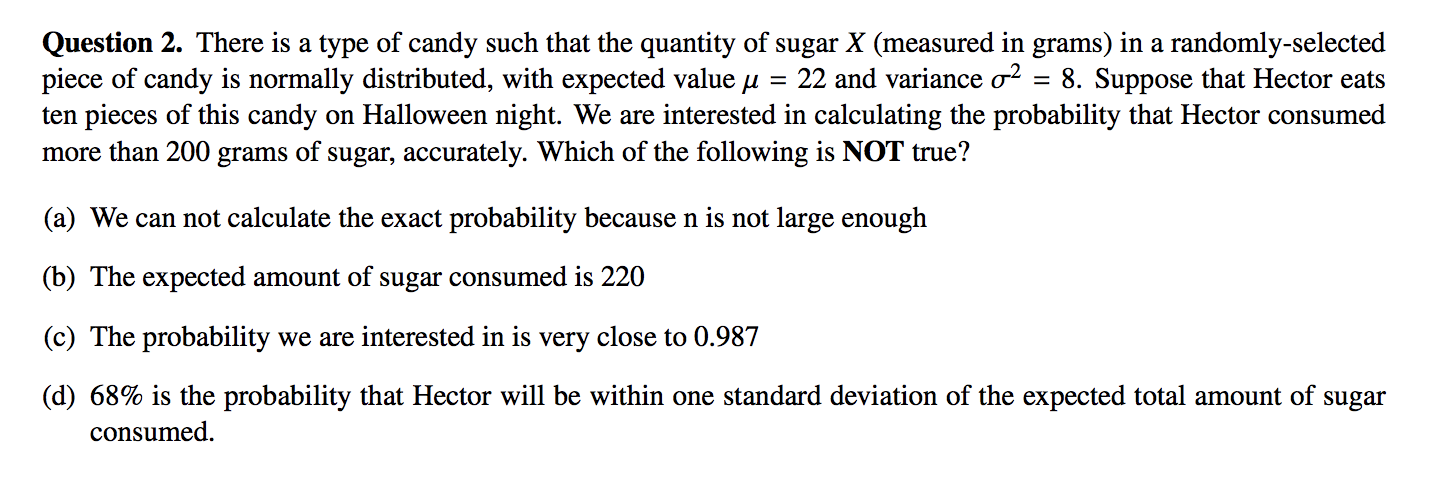Question 2. There is a type of candy such that the quantity of sugar X (measured in grams) in a randomly-selected piece of candy is normally distributed, with expected value u ten pieces of this candy on Halloween night. We are interested in calculating the probability that Hector consumed more than 200 grams of sugar, accurately. Which of the following is NOT true? = 22 and variance o? = 8. Suppose that Hector eats (a) We can not calculate the exact probability because n is not large enough (b) The expected amount of sugar consumed is 220 (c) The probability we are interested in is very close to 0.987 (d) 68% is the probability that Hector will be within one standard deviation of the expected total amount of sugar consumed.
Question 2. There is a type of candy such that the quantity of sugar X (measured in grams) in a randomly-selected piece of candy is normally distributed, with expected value u ten pieces of this candy on Halloween night. We are interested in calculating the probability that Hector consumed more than 200 grams of sugar, accurately. Which of the following is NOT true? = 22 and variance o? = 8. Suppose that Hector eats (a) We can not calculate the exact probability because n is not large enough (b) The expected amount of sugar consumed is 220 (c) The probability we are interested in is very close to 0.987 (d) 68% is the probability that Hector will be within one standard deviation of the expected total amount of sugar consumed.
MATLAB: An Introduction with Applications
6th Edition
ISBN:9781119256830
Author:Amos Gilat
Publisher:Amos Gilat
Chapter1: Starting With Matlab
Section: Chapter Questions
Problem 1P
Related questions
Question

Transcribed Image Text:Question 2. There is a type of candy such that the quantity of sugar X (measured in grams) in a randomly-selected
piece of candy is normally distributed, with expected value u
ten pieces of this candy on Halloween night. We are interested in calculating the probability that Hector consumed
more than 200 grams of sugar, accurately. Which of the following is NOT true?
= 22 and variance o? = 8. Suppose that Hector eats
(a) We can not calculate the exact probability because n is not large enough
(b) The expected amount of sugar consumed is 220
(c) The probability we are interested in is very close to 0.987
(d) 68% is the probability that Hector will be within one standard deviation of the expected total amount of sugar
consumed.
Expert Solution
This question has been solved!
Explore an expertly crafted, step-by-step solution for a thorough understanding of key concepts.
This is a popular solution!
Trending now
This is a popular solution!
Step by step
Solved in 2 steps with 3 images

Knowledge Booster
Learn more about
Need a deep-dive on the concept behind this application? Look no further. Learn more about this topic, statistics and related others by exploring similar questions and additional content below.Recommended textbooks for you

MATLAB: An Introduction with Applications
Statistics
ISBN:
9781119256830
Author:
Amos Gilat
Publisher:
John Wiley & Sons Inc

Probability and Statistics for Engineering and th…
Statistics
ISBN:
9781305251809
Author:
Jay L. Devore
Publisher:
Cengage Learning

Statistics for The Behavioral Sciences (MindTap C…
Statistics
ISBN:
9781305504912
Author:
Frederick J Gravetter, Larry B. Wallnau
Publisher:
Cengage Learning

MATLAB: An Introduction with Applications
Statistics
ISBN:
9781119256830
Author:
Amos Gilat
Publisher:
John Wiley & Sons Inc

Probability and Statistics for Engineering and th…
Statistics
ISBN:
9781305251809
Author:
Jay L. Devore
Publisher:
Cengage Learning

Statistics for The Behavioral Sciences (MindTap C…
Statistics
ISBN:
9781305504912
Author:
Frederick J Gravetter, Larry B. Wallnau
Publisher:
Cengage Learning

Elementary Statistics: Picturing the World (7th E…
Statistics
ISBN:
9780134683416
Author:
Ron Larson, Betsy Farber
Publisher:
PEARSON

The Basic Practice of Statistics
Statistics
ISBN:
9781319042578
Author:
David S. Moore, William I. Notz, Michael A. Fligner
Publisher:
W. H. Freeman

Introduction to the Practice of Statistics
Statistics
ISBN:
9781319013387
Author:
David S. Moore, George P. McCabe, Bruce A. Craig
Publisher:
W. H. Freeman